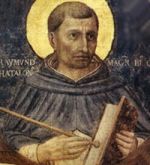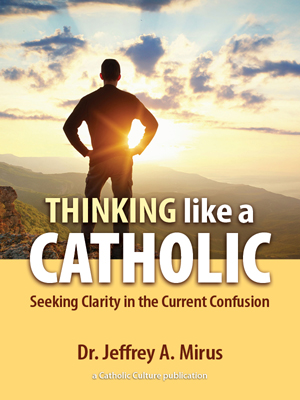Catholic Activity: History of the Feast of Corpus Christi
Father Francis Weiser describes the history of the Corpus Christi, including history of the feast, hymns and folklore.
DIRECTIONS
HISTORY AND LITURGY
ORIGIN — On Maundy Thursday, the day on which the Church commemorates the institution of the Holy Eucharist, it is impossible to honor the Blessed Sacrament with appropriate solemn and joyful rites. Such a festival is precluded by the sad and sorrowful memories of the day — the betrayal of Judas, Christ's agony and arrest, Peter's denial — and by the fact that other prescribed ceremonies are already occupying the time of clergy and faithful on Holy Thursday.1
It was a humble nun in Belgium, Saint Juliana (1258), Prioress of Mont Cornillon, who first suggested and advocated a special feast in honor of the Blessed Sacrament to be celebrated on a day other than Maundy Thursday.2 From her sixteenth year she had often in her prayers beheld a strange sight: it was as if the full moon appeared to her in brilliant light, while a part of its disc remained black and lightless. Finally, in a vision, Christ showed her the meaning of this picture. The moon represented the ecclesiastical year; the black spot indicated the lack of a festival in honor of the Blessed Sacrament. She was to announce to the authorities of the Church that God wished such a feast to be established.
In 1230 Juliana communicated her secret to a small group of learned theologians. As her message became publicly known, she had to suffer scorn and ridicule for some years. But the bishop of her diocese (Liége) and some of his canons eventually lent a willing ear to her appeals. A diocesan synod in 1246 decided in her favor and prescribed such a feast for the churches of Liége.3
Was it mere coincidence that one of the men who had supported her efforts in Belgium later became pope? He was Jacques Pantaléon, Archdeacon of Liége. Upon his election to the papal office he assumed the name of Urban IV (1261-1265). On September 8, 1264, six years after Juliana's death, he established for the whole Church that festival in honor of the Holy Eucharist which the saintly nun had proclaimed to be willed by God. It was to be celebrated with great solemnity on the Thursday after Pentecost week, and indulgences were granted to all who would receive Holy Communion or attend special devotions in addition to hearing Mass.
Urban IV commissioned the great Dominican scholar Saint Thomas Aquinas to compose the texts of Mass and Divine Office for the new feast. The splendor, depth, and devotion of the prayers and hymns that Saint Thomas wrote have enriched the liturgy with one of its most beautiful rituals. They are still in use today, admired and appreciated by people of all faiths.
The bull of Urban IV had no immediate effect because he died soon after its publication, and the succeeding popes did not urge the matter. Finally, however, Pope Clement V, in 1314, renewed the decrees in a bull of his own, and then the feast spread quickly throughout the Latin Church. Later it was also accepted by some parts of the Oriental Church (Syrians, Armenians, Copts, and Melchites). The churches of the Greeks, Ukrainians, and Russians (of the Greek Catholic Rite) do not celebrate this feast.
Corpus Christi is a holyday of obligation. In the United States, however, the faithful are exempt from the obligation by a special dispensation of the Holy See.
NAMES — The official title of the feast is, in the Latin Church, Festum Sanctissimi Corporis Christi (Feast of the Most Holy Body of Christ). In Greek it is called Tou Somatos Tou Kyriou Heorte (Feast of the Body of the Lord). From these ecclesiastical terms many Christian nations have adopted popular names for the feast, like the English and Spanish Corpus Christi, the German Fronleichnam (Body of the Lord), the Slavic Boze Telo (Body of God), the Syriac pagre d' maran (Body of the Lord), and the Arabic 'id el-jesed el-ilahi (Feast of the Body of God). Other names are Fête Dieu (Feast of God) in French, Úrnapja (Day of the Lord) in Hungarian, Brasancevo (Sacred Bread) among the southern Slavs.
Activity Source: Handbook of Christian Feasts and Customs by Francis X. Weiser, S.J., Harcourt, Brace and Company, New York, 1958






